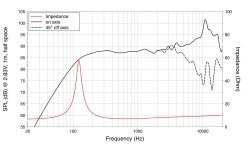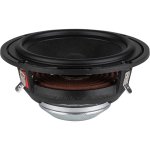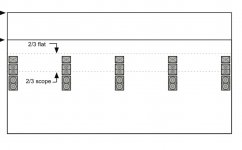That'll be a very nice setup...BMS makes a great drivers.
I don't see anything directly comparable to the M74 specs. It has very high mid range sensitivity above 400hz for a 3" diameter emitter.
Cost isn't low but the quality and performance is (probably) there. Certainly cheaper and longer lasting than many other hobbies.
I don't see anything directly comparable to the M74 specs. It has very high mid range sensitivity above 400hz for a 3" diameter emitter.
Cost isn't low but the quality and performance is (probably) there. Certainly cheaper and longer lasting than many other hobbies.
Purifi has the game down for the woofers and the 8" will be interesting. We should have more info soon. BlieSMa have good control of tweeters (pun intended) and BMS is also a good choice for sub woofers.
The Purify 4" will be interesting, but there is, potentially interesting driver.
LaVoce FAN30.71 fullrange driver. 3" paper cone, neodym magnet, Le is only 0.05mH, Cms is 0.9mm/N, Mms is 1.8g, sensitivity of 89.5dB, Fr range is 120hHz-3kHz and Rms is 0.288kg/s (excellent Rms)
There is currently no independent measurement available for this driver, but I might do one at a later stage.
Rms for the M74B is 0.654kg/s.
The Purify 4" will be interesting, but there is, potentially interesting driver.
LaVoce FAN30.71 fullrange driver. 3" paper cone, neodym magnet, Le is only 0.05mH, Cms is 0.9mm/N, Mms is 1.8g, sensitivity of 89.5dB, Fr range is 120hHz-3kHz and Rms is 0.288kg/s (excellent Rms)
There is currently no independent measurement available for this driver, but I might do one at a later stage.
Rms for the M74B is 0.654kg/s.
Attachments
Yeah for my front mains, left and right centres, and centre, I’ll use 4x 8” Purifi woofers crossed over the the Bliesma mids. 20x Purifi 8’s should cover the front wall nicely. And 4-8 BMS 15N18V2’s for the sub channels.
http://www.bmsspeakers.com/fileadmi...ium/bms_15n850v2_2011-04_neodymium_woofer.pdf
http://www.bmsspeakers.com/fileadmi...ium/bms_15n850v2_2011-04_neodymium_woofer.pdf
Attachments
Last edited:
Member
Joined 2003
LaVoce FAN30.71 fullrange driver. 3" paper cone, neodym magnet, Le is only 0.05mH, Cms is 0.9mm/N, Mms is 1.8g, sensitivity of 89.5dB, Fr range is 120hHz-3kHz and Rms is 0.288kg/s (excellent Rms)
There is currently no independent measurement available for this driver, but I might do one at a later stage.
Interesting driver and the price is right at USD$29, but 2mm xmax and 30W power handling will certainly go up in smoke for Amplifier dude's requirements 😉
Doesn't everyone know that Vifa/Tymphany/Peerless/Vline TC9 and TG9 is the perfect midrange for home use? TG9FD1004 is the 4 ohm variant with enough sensitivity for most people. Hificompass has shown excellent performance of the TC9 as have others and it's only $20. I was certainly a big fan of the TG9 when I used it.
Last edited:
I'll take it that homecinema is a very serious thing for you 🙂 - You should pair those speakers with a balanced amplifier, Circlotron/SuSy topology, well worth it since you already are going all in on drivers.
As a side note, I started looking at Circlotron - Jfet buffer and either Lateral MOSFET or power JFet outstage. First 25W in class A and remainder up to some 100-120W in class AB (8 ohm). I wouldn't want to
spend a fortune on drivers, crossover etc. and use a SE paralleled amplifier, but that is I guess, a discussion for another day 🙂
As a side note, I started looking at Circlotron - Jfet buffer and either Lateral MOSFET or power JFet outstage. First 25W in class A and remainder up to some 100-120W in class AB (8 ohm). I wouldn't want to
spend a fortune on drivers, crossover etc. and use a SE paralleled amplifier, but that is I guess, a discussion for another day 🙂
I disagree due to the existence of the S.S Discovery 15M/4624G00. Look at the stored energy (cumulative spectral decay). This is a "fast" driver.Doesn't everyone know that Vifa/Tymphany/Peerless/Vline TC9 and TG9 is the perfect midrange for home use?
ScanSpeak 15M/4624G00 | HiFiCompass
Isn't this going a little off topic by now?
Is that home cinema something for yourself or for a bigger audience?
Because in a more professional setting, I would never recommend using some fancy hifi speakers in general (there are a few exceptions)
That just has to do with longevity and reliability under heavy usage on a daily basis.
Or in very simple words, there is more than just pure raw speaker performance.
Especially when it's a business that can't effort of speakers blowing up or breaking for whatever reason that might be.
Is that home cinema something for yourself or for a bigger audience?
Because in a more professional setting, I would never recommend using some fancy hifi speakers in general (there are a few exceptions)
That just has to do with longevity and reliability under heavy usage on a daily basis.
Or in very simple words, there is more than just pure raw speaker performance.
Especially when it's a business that can't effort of speakers blowing up or breaking for whatever reason that might be.
That literally doesn't mean anything and there is no such thing as a fast driver.Look at the stored energy (cumulative spectral decay). This is a "fast" driver.
Member
Joined 2003
Mister "I disagree with everyone else" 😀. First thing first, the 15M have a nice roll-off which make the filter an easy job. Second, fast is a terminology people use. It might not be technically correct, but it refer to the drivers transient performance,That literally doesn't mean anything and there is no such thing as a fast driver.
and that matters big time. Smearing is directly related to wrong Q of the box (under dampened) of filter or using a driver that has a terrible CSD. Further, looking at the harmonic noise as well as Le, Cms etc ... Tell a story.
You either have a well controlled low distortion driver or you don't. There are lots of average performing drivers present and some of them have been measured by Yevgeniy.
While the data doesn't tell you 100% if you like it or not, it can tell you the direction of the driver. Or perhaps why paper often is a good contender among exotic materials. To say it doesn't mean anything is like stating spinorma data and directivity
vs frequency can't tell you anything...
These are all tradeoffs that we like to sit around and debate as keyboards warriors.
Yevgeniy,
How can we help you?
Have you considered putting a "Buy me a coffee" link on your website. So we can do a donation via Paypal. Otherwise please advise.
Yevgeniy,
How can we help you?
Have you considered putting a "Buy me a coffee" link on your website. So we can do a donation via Paypal. Otherwise please advise.
^^^
I am considering sending him the LaVoce driver (sponsor) such that it can be measured in his system and compared to his library.
I am considering sending him the LaVoce driver (sponsor) such that it can be measured in his system and compared to his library.
I'll take it that homecinema is a very serious thing for you 🙂 - You should pair those speakers with a balanced amplifier, Circlotron/SuSy topology, well worth it since you already are going all in on drivers.
As a side note, I started looking at Circlotron - Jfet buffer and either Lateral MOSFET or power JFet outstage. First 25W in class A and remainder up to some 100-120W in class AB (8 ohm). I wouldn't want to
spend a fortune on drivers, crossover etc. and use a SE paralleled amplifier, but that is I guess, a discussion for another day 🙂
I make my own DSP amps already. Shared the THD+N a few posts back. They use Ravenna AES67 audio over IP so unlimited units can be clock synced. Each one has 4 channels of DSP, and 3 Purifi 1ET400A modules inside, and an XLR sub out. So good for a 3 way and sub each. Finally got Trinnov and Storm Audio on board with the Ravenna. So with their 32 channel processors combined with my DSP amps up to 128 drivers can be actively driven in a single home theatre. With audio quality on par with the best of the best 2 channel dac’s and amps to each driver. The amps build into the wall and have fibre optic Ethernet inputs. So there’s very short speaker wire runs to the drivers.
Attachments
Isn't this going a little off topic by now?
Is that home cinema something for yourself or for a bigger audience?
Because in a more professional setting, I would never recommend using some fancy hifi speakers in general (there are a few exceptions)
That just has to do with longevity and reliability under heavy usage on a daily basis.
Or in very simple words, there is more than just pure raw speaker performance.
Especially when it's a business that can't effort of speakers blowing up or breaking for whatever reason that might be.
It’s for people who want the best possible and don’t have financial issues holding them back.
Mister "I disagree with everyone else" 😀.
Ehm actually no, a lot of people agree with me/this.
If you want to be technically, the "thing" that makes a speaker "fast" can extremely easily be seen.
It's called "the frequency response"
When a system is slow, the freq resp collapses.
I would recommend reading your standard control theory book for that, otherwise the usual books from Borwick, Eargle, Mellow and Beranek.
At least they all 100% agree with that fact that there is no such thing as "a fast speakers". Unless you're talking about the frequency response.
Which is just a little silly way to describe the frequency response itself.
Last edited:
If that's the case, have fun and good on ya! 😀 😎It’s for people who want the best possible and don’t have financial issues holding them back.
Although I still wouldn't use 4 inchers for a high quality home cinema 🙄
b_force: Transient performance has nothing to do with frequency response per say and all to do with how the driver performs in the time domain which is visible via Cumulative Spectral Decay, Step Response and Harmonics.
On axis response cannot show what is happening in the time domain (CSD) just as it cannot show if a driver have dominant H2 or H3. Take Accuton diamond BD25 tweeter. Looking at the on axis response, this driver is near
perfect up to 10kHz with some "issues" 10-20kHz. What you don't see is the harmonic spike happening right in the sibilance region which contributes to to it sounding a bit fatiguing after prolonged listening.
The frequency response will not show you this or the splendid CSD performance which the BlieSMa T25D-6 also have but non of the harmonic BS Accuton offers. I don't care how many gurus there are claiming a simple frequency
response graph can tell you a drivers transient performance - aka transition - It cannot and never will.
Accuton BD25-6-258 | HiFiCompass
BlieSMa T25D-6 | HiFiCompass
On axis response cannot show what is happening in the time domain (CSD) just as it cannot show if a driver have dominant H2 or H3. Take Accuton diamond BD25 tweeter. Looking at the on axis response, this driver is near
perfect up to 10kHz with some "issues" 10-20kHz. What you don't see is the harmonic spike happening right in the sibilance region which contributes to to it sounding a bit fatiguing after prolonged listening.
The frequency response will not show you this or the splendid CSD performance which the BlieSMa T25D-6 also have but non of the harmonic BS Accuton offers. I don't care how many gurus there are claiming a simple frequency
response graph can tell you a drivers transient performance - aka transition - It cannot and never will.
Accuton BD25-6-258 | HiFiCompass
BlieSMa T25D-6 | HiFiCompass
If I can get up to 120dB out of the 3” Bliesma mids why wouldn’t I use them?
Because I highly doubt that in practice.
It's already quite difficult to get that out of a proper compression driver continuously and reliable.
A 10*log for power is definitely not gonna help you either with that.
Don't really know what model etc we are talking about.
But assume it has 97dB/W sensitivity.
Means that in theory we need at least 10^(23/10) = 200W of power
Not taking any things into account like power compression, and other things that heat up an ruin your day.
Poor little thing 🙁
ATC gets 118dB continuous out of their 3” mid without breaking a sweat. And that’s crossed over at 380hz.
SCM200ASL Pro | ATC Loudspeakers
Stan already told me that 115.4dB is possible with no issues crossing the M74B at 600hz with a 4th order. At 900-1000hz 120dB shouldn’t be a problem. 200w isn’t an issue from the 450w amp driving them.
SCM200ASL Pro | ATC Loudspeakers
Stan already told me that 115.4dB is possible with no issues crossing the M74B at 600hz with a 4th order. At 900-1000hz 120dB shouldn’t be a problem. 200w isn’t an issue from the 450w amp driving them.
Last edited:
- Home
- Loudspeakers
- Multi-Way
- Some speaker driver measurements...



